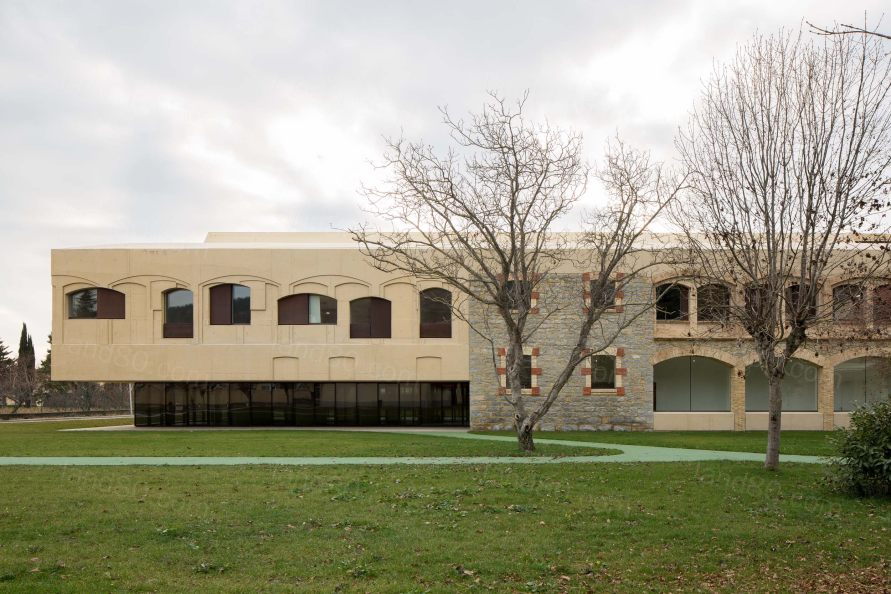项目是一次对记忆的反思:探讨时间的流逝和建筑的演变。设计方案将一座19世纪建筑进行改造,过去的痕迹刻在新建筑中,就像古代几何的记忆一样......这是一座未完成的建筑,时间会为它画上终点。
The project is a reflection on memory: the pass of time
and the evolution of architecture...
The proposal is a way to intervention in a 19th century
building ... the traces of the past are engraved in the new buildings, like a
memory of ancient geometries ... It is an unfinished architecture that the time
will end up composing in the place ...
▽项目概览




▽不同角度的立面




干预方案Intervention Proposal
设计方案保留并增强了建筑原有的价值:19世纪建筑中的阁楼式建筑类型,优美景色中宜人的尺度,阁楼之间的有趣空间,以及规模恰当、比例适中的庭院,这些在患者与环境之间建立了良好的连接,同时也展现了自然与建筑之间完美的关系。
The proposal maintains and enhances the original values:
pavilion typology in a 19th century building, pleasant scale in a landscaped surround,
but neglected until now: interesting spaces between pavilions, suitable scale, well-proportioned
patios: good connection between the patient and the concrete environment and
environmental: perfect relationship between nature and architecture.



设计旨在强调原始的“保健精神”和“治疗精神”,有利于提供专业的治疗和日常活动,作为照顾病人的基本治疗元素。因此,建筑与“家庭”性质的关系被重新聚焦,外部空间和庭院在交通流线之间应运而生。
The aim is to enhance the original "hygienist
spirit" and "therapeutic spirit" favouring occupational therapy
and dailyactivities as fundamental treatments elements for good care ofpatients:
thereforethe relationship of architecture with the "domesticated"
nature is re-focused, the exterior spaces and courtyards generated between the
general circulations...



“义肢”策略Prosthetic Strategy
项目旨在让新旧建筑之间相互融合,试图充分利用现有建筑的价值,并通过新的“外表”使其成为可能,建筑的外涂层可以重新激活所需的功能:作为一种功能性的“义肢”而存在。就像义肢帮助使用者恢复失去的功能一样,建筑的扩建部分同样找回了其功能,经过重新配置的空间使新功能成为可能,此外还修复了建筑结构,以适应新的医疗保健趋势并吸收新技术。
The project aims to offer a hybrid between new and old
buildings, trying to make the most of the values of
the existing and making it possible thanks to new "dressings" that
re-vitalize the desired function: as a functional "prosthesis". In the same way that prostheses help the original member
to recover a lost function, in this case they reconfigure the space and make
possible the new functions, in addition to complementing the structure to
accommodate the new healthcare trends and channel and assimilate the new
technologies.
▽走廊空间




新旧之间的诗意关系 Poetic relationship between the new and the
old
设计产生了与原有建筑相似的“氛围”,由现代灵活的技术建筑系统支持,供未来使用,并受到现有建筑的启发实现新旧建筑的相辅相成。这是一个平衡的方案,遵循旧建筑的几何图案,但从自身功能所需出发进行设计。
It is intended to generate an "atmosphere"
analogous to the existing one, through buildings of contemporary invoice,
supported by current and flexible technological construction systems for their
future use, and inspired by existing architectures, with which they should
complement and mutually revalue. It is a balanced proposal that follows the geometrical patterns of the old buildings but undertakes its design from its own functionality.


建筑在形式上呈现出一种永恒的姿态:得到恢复的几何形状屋顶,拱门、线性建筑、无限延伸的几何形态得以重新利用。
The buildings provide timeless gestures in their formal
resolution: recovery of the geometry of the roofs; reuse of the geometries
derived from the arch, rectilinear buildings, infinite distributors,...
▽几何形状屋顶

混凝土结构 Construction in concrete
整座建筑都是用结构建筑混凝土建造而成,包括外墙和屋顶,因此整座建筑就像一根巨大的梁。混凝土被整体染成水泥色,包裹着石材和旧建筑的砖块。通过这种方式,色彩便成为一个整体,主导整个项目的氛围。旧建筑拱门的几何形状被雕刻在新立面上,作为一种“记忆”永远留存在建筑中。随着时间的流逝,建筑物将会变黑并呈现出旧建筑物的铜绿,这取决于其阳光和盛行风的作用,新旧建筑也将逐渐融为一体。
The entire building is constructed in structural
architectural concrete - facades and roofs - so the entire construction acts as
a large beam. The concrete is dyed in mass with the colour of the cement that
joins the stones and the brick of the old buildings. In this way, it is
intended to take the colour of the dominant atmosphere as a whole. The
geometries of the arches of the old buildings are engraved on the new facades,
as a "memory" ... the memory of what was left ... with time, the
building will blacken and take on the patina of the old buildings, depending on
its orientation and dominant winds, and little by little the building will
blend with the previous ones ...
▽水泥色的外墙包裹着石材和旧建筑的砖块


▽室内也是统一色调


▽总平面图

▽分层平面图
▽立面图

▽剖面图

▽细节

▽模型

▽立面设计推演


Authors Architects
Vaillo+Irigaray Architects, Galar, Vélaz
www.vailloirigaray.com
Antonio Vaíllo i Daniel, Juan L. Irigaray Huarte
Daniel Galar, Josecho Vélaz
Location:Pamplona, Navarra, Spain
Area: 9.820 m2
Project Year:2012
Client: Servicio Navarro de Salud – Osasunbidea
Structural Engineering: Raúl Escrivá – OPERA Ingeniería
Facilities Engineering: José Javier González – GE ingenieros
Photographer: Rubén P. Bescós (rubenpb@rubenpb.com)
Masterplan
Competition 1: September 2009
Project: April 2010
Cost: 65.500.280 €
Surfaces
Masterplan:291.455 m2
Total Gross Area:51.966 m2
Stages I & II
Competition 2: December 2010
Project: April 2012
End of Construction: 2017
Cost: 11.635.772 €
Surfaces: 9.820 m2
|